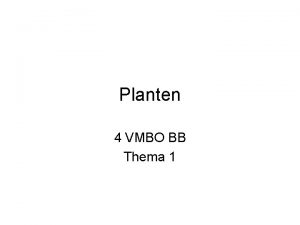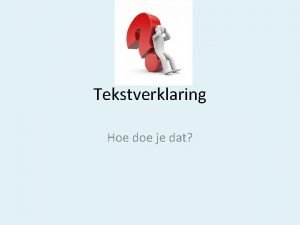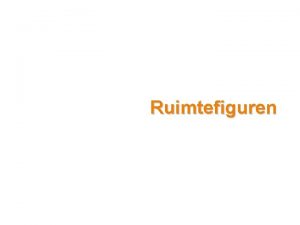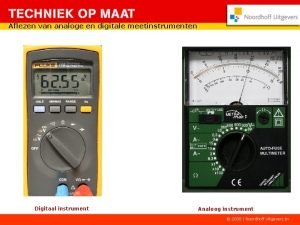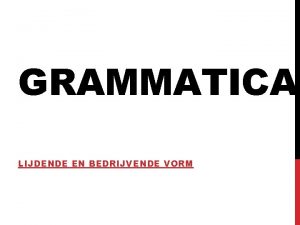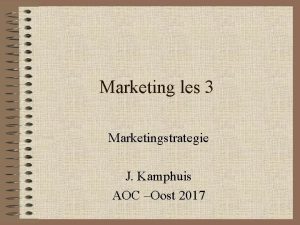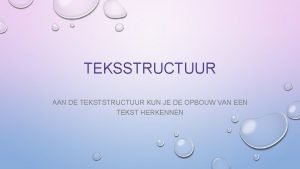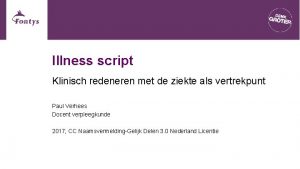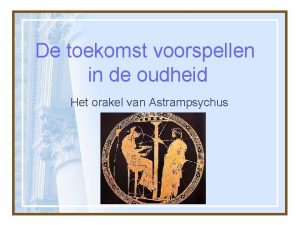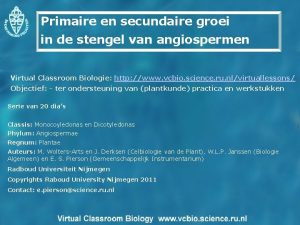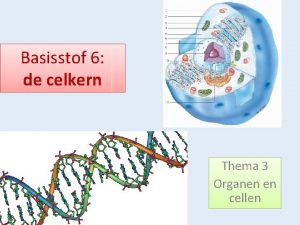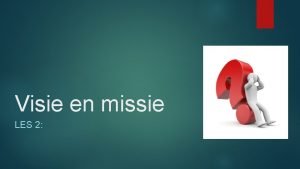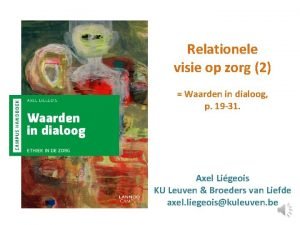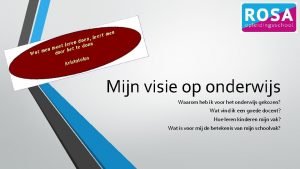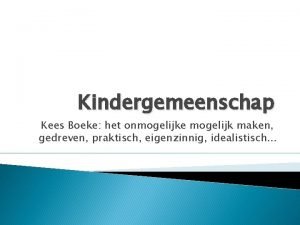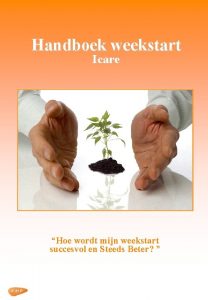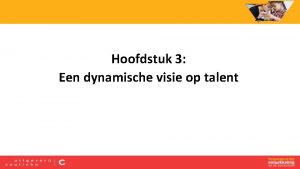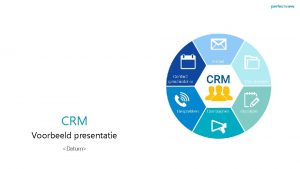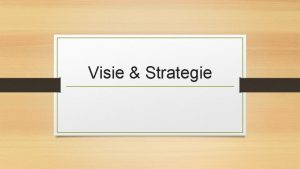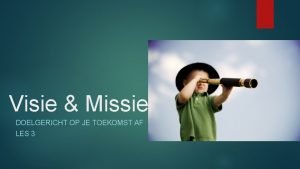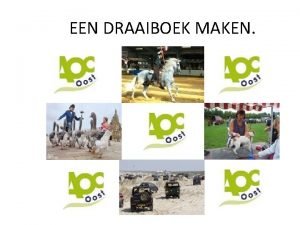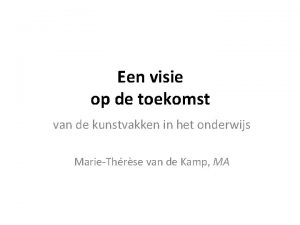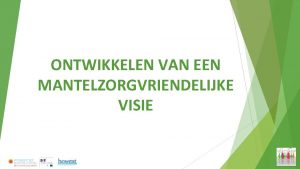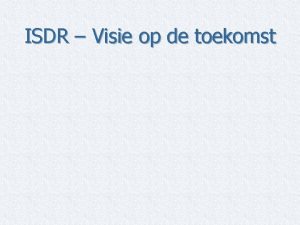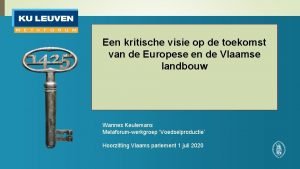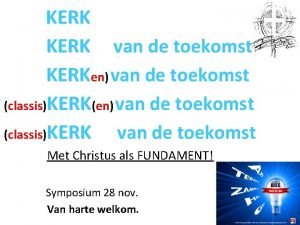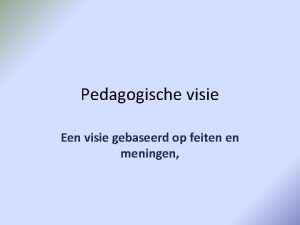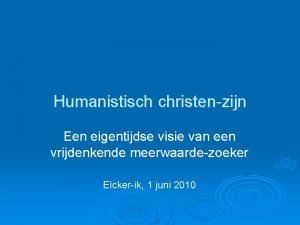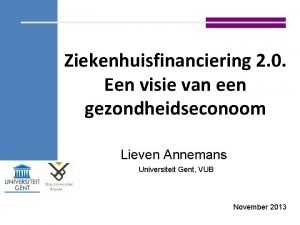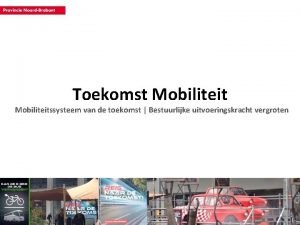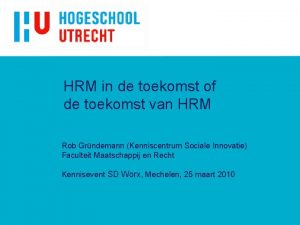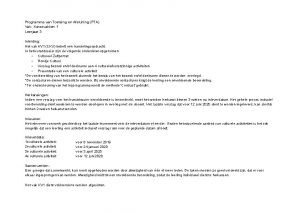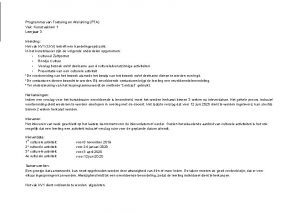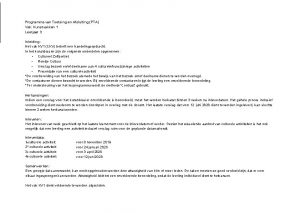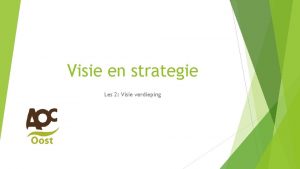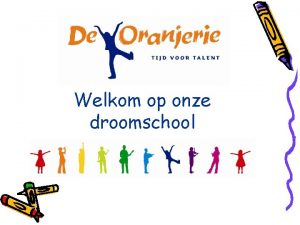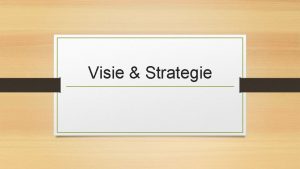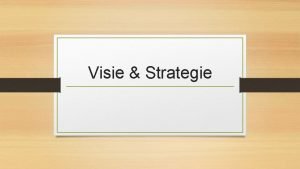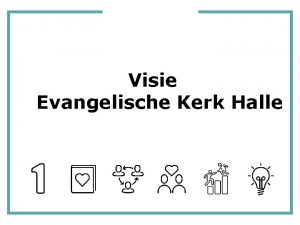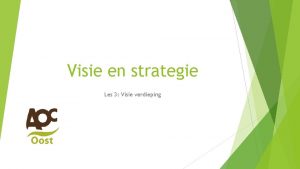Een visie op de toekomst van de kunstvakken
























- Slides: 24

Een visie op de toekomst van de kunstvakken in het onderwijs Marie-Thérèse van de Kamp, MA

Een visie op leren & Kunst • Een visie op leren • Een visie op de context van onderwijs • Een visie op kunstonderwijs • Een visie op de toekomst van het kunstonderwijs in een ‘global’ world.

Leren = • Kennis wendbaar toepassen (Ebbens) • Ervaringsgericht leren (embodied learning) in authentieke contexten • Een sociaal-cultureel proces: Rol van emoties bij het leren & empathie (Immordino-Yang) • Kennis construeren samen met anderen • Metacognitie & reflectie bij het leren -> verdiepend leren

Onderwijs in de context van de ‘Global world’ - Actuele ontwikkelingen - Wetenschappelijke inzichten uit de professionele discipline - Opbouwen van relevante kennis, inzichten en vaardigheden voor de toekomst - The disciplinary, synthesizing, creating, respectful & ethical mind. Gardner in ‘Five Minds for the Future’. - Flexpertise: educating for the unknown – Perkins.

Kunst = • Het postmodernisme is voorbij (kritiek op het relativisme, de vrijblijvendheid en het oppervlakkig historicisme, de doodlopend weg van nostalgie en traditionalisme) • Heroriëntatie op modernisme en moderniteit (als gevolg van de wens tot internationalisering en modernisering van veel opkomende, niet-westerse mogendheden) • Whitney Biennale 2008 ‘Between the history of forms and the forms of history’

Whitney Biënnale 2008 Recurring concerns involve a nuanced investigation of social, domestic, and public space and its translation into form—primarily sculptural, but also photographic and cinematic. Many artists reconcile rigorous formal and conceptual underpinnings with personal narratives or historical references. While numerous works demonstrate an explicit or implicit engagement with art history, particularly the legacy of modernism, as well as a pronounced interest in questioning the staging and display of art, others chart the topography and architecture of the decentralized American city and take inspiration from postindustrial landscapes and urban decay.

Whitney Biënnale 2008 Using humble or austere materials or employing calculated messiness or modes of deconstruction, they present works distinguished by their poetic sensibility as they discover pockets of beauty in sometimes unexpected places. There is an evident trend toward creating work of an ephemeral, event-based character, in the form of music and other performance, movement workshops, radio broadcasts, publishing projects, community-based activities, film screenings, culinary gatherings, or lectures.

Kunstonderwijs in de ‘Global World’ - Discipline-gebaseerd leren – referentiekader: professionele kunsten (niet starten vanuit ambachtelijke of technische vaardigheden) - Resource-based leren – leren over/van echte kunst - Hybriditeit, creativiteit en innovatie als kernconcepten voor de productie van kunst - Multi-en Interdisciplinariteit in de kunsttheorie - Verschillende culturele perspectieven: High art, low culture, interculturele

Discipline-gebaseerd leren: - Professionele discipline = uitgangspunt - Discipline Kunst: de kenmerkende manier van denken van kunst (= symboolsysteem) leren aan de hand van de kernconcepten - Kunst is zowel productief, receptief als reflectief. - Kunst = muziek, dans, drama en beeldende kunst en de wetenschappelijke disciplines t. a. v. de kunsttheorie - Misconcepties voorkomen & verdiepend leren.

Resource-based leren: - Leren van echte Kunst - Ervaringsgericht & authentiek leren (embodied & problembased learning) - Echte Kunst uit heden en verleden - Begrippenkennis & leren beschouwen van Kunst (beeldend, dans, drama, muziek) - Complexiteit van kunst erkennen

Creativiteit en innovatie centraal: • Leren over creatieve processen in de kunst • Creativiteit – uitkomsten uit wetenschappelijk onderzoek opnemen • Meer aandacht voor problemfinding in het kader van innovatie • Aandacht besteden aan het ontwikkelen van meta-cognitieve aspecten van het creatieve leerproces

Mono, multi/interdisciplinariteit • Kunstproductie binnen een symboolsysteem (visueel-ruimtelijk; muzikaal-ritmisch; lichaams-kinesthetisch) • Hybriditeit – interdisciplinaire vormen van kunst: grensoverschrijdingen binnen de traditionele monodisciplines • Multi- of interdisciplinariteit in de kunsttheorie: analyseren van hybride vormen van kunst , invloed van cultural studies, visual literacy, postkolonialisme, invloed filosofie, enz.

Cultuurvisies & Interculturaliteit • Van High art tot low culture– opera, schilderkunst, moderne theaterdans tot popmuziek, mode, videoclips • Van jeugdcultuur tot straatcultuur • Van westerse cultuurcanon tot interculturaliteit

Hedendaagse context: • Als docent kunstvakken zou je op de hoogte moeten zijn/blijven van actuele ontwikkelingen in: • de wereld • de hedendaagse maatschappij • de professionele kunst/kunsttheorie • onderwijskundige en vakdidactische ontwikkelingen

WAAROM? Zo kun je een goed onderbouwde visie op kunstproductie, kunsttheorie, onderwijs en de legitimatie van kunstvakken in het onderwijs in praktijk brengen

Recente ontwikkelingen • Terrorisme-dreiging & oorlog angst, dreiging, dood • Accent op verschillen door religie • Vrijheid van meningsuiting & engagement • Global village nieuwe visies op moderniteit • Opkomst Azië, Afrika en Zuid-Amerika – het westen wordt de oude wereld (financiële crisis) • Klimaat/milieu problemen e. d. (millenniumdoelen) • Innovatie/creativiteit/technologie als motor van de economie en van duurzaamheid (milieu) • Hybride kunstvormen

Hybriditeit In de kunsten

Hybriditeit • Postkolonialisme • Nieuwe vormen, gemengd uit bestaande vormen • Context: Homi K. Bhabha - Gemengde afkomsten - Interactie: culturen/creatieve activiteiten (relatie tussen voormalige koloniën en hun koloniale overheersers) - Nieuwe interdisciplinaire vormen van kunst

Hybrid Art • In art forms, hybridity could mean the blurring of traditional distinct boundaries between artistic media such as painting, sculpture, film, performance, architecture, and dance. • It also can mean cross-breeding art-making with other disciplines, such as natural and physical science, industry, technology, literature, popular culture, or philosophy. • Hybrid art forms expand the possibilities for experimentation and innovation in contemporary art.

Freedom • Today’s artists are free to make art with whatever material or technique they can imagine. • This freedom creates new opportunities to express ideas and concepts. • It also opens up a number of challenges, choices, and decisions for artists:

Blurring Boundaries • Should I work to master a traditional art form or • Should I work to create innovative new art forms? • Or should I do both? • Should I experiment with materials that are industrial or outside the scope of my studio if those materials seem to be the best way to express my artistic goals? • How can I define myself as an artist if I am shifting, combining, and recombining techniques from inside and outside the worlds of art?

Innovative Art Today • Blurring boundaries, breaking rules, and creating hybrids occupies much artistic work today. • However, making meaning in art—whatever tools, materials, or techniques are used—remains central to artistic practice. • It is important for viewers to keep this in mind as they explore innovative art today. Bron: Walker Art Center, Minneapolis

Getoonde kunstenaars: • • • • • Fabian Marcaccio Eberhard Havekost Pierre Huyghe Dogtroep Eric de Vroedt: Julie Mehretu: Banksy Dansgroep Krisztina de Châtel Akram Khan David La. Chapelle Spike Jonze John Galliano Madonna Kara Walker Reza Abedini Lesley Vance Jannis Kounellis Melanie Pullen Bill Viola: opera decors Nadav Kander • • • • • • Edgar Cleijne & Ellen Gallagher Folkert de Jong Hussein Chalayan Ronan & Erwan Bourroulec Pipilotti Rist Sixes Last Apple design: Jonathan Ive Marcel Wanders Michel Gondry Michel Blazy David Altmejd Michael Raedecker Martin Creed Matthew Barney Writing to Vermeer Lightfoot/Léon Dennis Darzaq Thomas Houseago Santiago Calatrava Brian Jungen Saskia Olde Wolbers

Literatuur: • • • • • Addison, N. , L. Burgess, ed. (2006) Learning to Teach Art and Design in the Scondary School. Bhabha, Homi. K. (1994) The Location of Culture Bhabha, Homi. K. (2006) Without Boundary. Fereshteh Daftari & Orhan Pamuk ed. Ebbens, S. , & Ettekoven, S. (2005) Actief Leren. Tweede druk. Efland, A. D. (2002) Art and Cognition. Integrating the Visual Arts in The Curriculum. Freedman, K. (2003) Teaching Visual Culture. Gardner, Howard. (1983) Frames of Mind. Gardner, Howard. (2006) Five Minds for the Future. Haanstra, F. (2001) De Hollandse Schoolkunst. Mogelijkheden en beperkingen van authentieke kunsteducatie. Hargreaves, D. (1995). Kunstzinnig onderwijs. Een vak op zich. Naar een andere visie op kunsteducatie. In: Haanstra, F (red. ) Determinanten van leren over kunst. Katernen kunsteducatie. Heartney, Eleanor. (2008) Art & Today. Hetland. L, E. Winner. (2007). Studio Thinking. The real benefits of visual arts education. Immordino-Yang (2009) Our Bodies, Our minds & Our Selves. Neurobiological perspectives on emotion, social interaction and learning. (presentatie bij Harvard GSE Future of Learning, 4 -7 aug. 2009) http: //www-rcf. usc. edu/~immordin/papers/Immordino. Yang_2009 inpress_Ourbodiesourminds. pdf Lindström. L. (1998) Criteria for assessing student performances in the Visual Arts. Nekuee, Shervin. (2001) Hybriditeit heeft de toekomst (op website De Balie) Perkins, D. (2008) Making Learning Whole. Runco, Marc. A. Creativity. (2007) Theories and Themes: research, development and practice. Sawyer, R. Keith. (2006). Explaining Creativity. The Science of Human Innovation. Vermunt, J. D, N. Verloop. (1999) Congruence and friction between learning and teaching. Walker Art Center, Minneapolis. Hybrid Art Forms. http: //schools. walkerart. org/arttoday/index. wac? id=2355 Website geraadpleegd op 22 oktober 2008.
 Wat is visie en missie
Wat is visie en missie Ongeslachtelijke voortplanting planten
Ongeslachtelijke voortplanting planten Hoe herken je een inleiding
Hoe herken je een inleiding Hoekpunten piramide
Hoekpunten piramide Digitale meetinstrumenten
Digitale meetinstrumenten Bedrijvende vorm
Bedrijvende vorm Pmc product markt combinatie
Pmc product markt combinatie Voor nadelenstructuur
Voor nadelenstructuur Mobiliteit in de toekomst 2030
Mobiliteit in de toekomst 2030 Illness script
Illness script Orakel van dodona
Orakel van dodona Dwarsdoorsnede stengel zonnebloem
Dwarsdoorsnede stengel zonnebloem Hoeveel chromosomen bevat de kern van een cel van je lever
Hoeveel chromosomen bevat de kern van een cel van je lever Visie versus missie
Visie versus missie Visie / missie pyramide
Visie / missie pyramide Traditionele visie
Traditionele visie Mijn visie op onderwijs
Mijn visie op onderwijs Kees boeke sportschool
Kees boeke sportschool Medewerkersportaal dimence
Medewerkersportaal dimence Missie visie abn amro
Missie visie abn amro Dynamische visie
Dynamische visie Aanleiding voorbeeld
Aanleiding voorbeeld Verschil missie en visie
Verschil missie en visie Missie versus visie
Missie versus visie Wat is een draaiboek voorbeeld
Wat is een draaiboek voorbeeld

